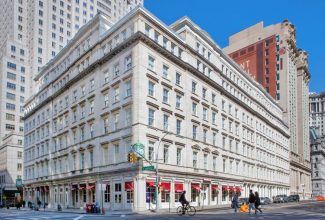October 27, 2020 Project of the Week

Project Name: RTA Bus Operations & Maintenance Facility
Company Name: Stantec
Project Location: San Luis Obispo, California United States
Project Information/Details: The San Luis Obispo Regional Transit Authority (RTA) recently broke ground on a new bus operations and maintenance facility. Top ten global design firm, Stantec, planned and designed the bus facility, which will play a vital role in the RTA’s ability to deliver safe, reliable transit services for San Luis Obispo County. In support of the agency’s wide coverage area, the facility was programmed to operate, service and maintain RTA’s entire fleet and serve as the headquarters for the agency. The facility will house the approximately 65 transit vehicles that will dispatch out of this location. The remainder of the future 112 vehicle fleet will dispatch from RTA’s several small park-out facilities across the county. The 27,500-square-foot operations and maintenance facility will include parking for up to 67 public transit vehicles, as well as 84 visitor and employee vehicles, and will include 5 repair bays, parts storage, and locker rooms. The facility—designed with efficiency in mind—reflects the agency’s close-knit, family atmosphere, and will feature a large shared breakroom that opens out to an employee patio. The RTA facility is designed to meet the requirements of California’s Green Building Code (CalGreen). The sustainable building design completely eliminates the operational use of fossil fuels on-site, maximizes the potential for photovoltaic power generation on the building roof and over vehicle parking, utilizes ultra-local building materials, and has been designed to accommodate a future all-electric vehicle fleet to be implemented by 2040. “It’s exciting to see the San Luis Obispo RTA bus operations and maintenance facility reach this critical milestone,” said Will Todd, Stantec project manager. “This is a project that will truly belong to the people who use it. We worked closely with San Luis Obispo RTA to design a sustainable, high-performance facility designed to meet the comfort of the agency’s workforce, with ample room for future growth.” “We are pleased to be breaking ground on this exciting project for the RTA. This new facility is an important part of the infrastructure in our county and for all of the people who use and work with RTA and Runabout transit services,” said Geoff Straw, RTA Executive Director. “We are grateful to our many partners— including Stantec; general contractor, Specialty Construction; and construction manager consultant, Kitchell CM— who have helped us reach this milestone, and we look forward to working with them until this project reaches completion.” Stantec provided architecture, civil engineering, survey, landscape architecture, mechanical and plumbing engineering, industrial architecture, telecom design, and fire protection engineering on the project. The San Luis Obispo RTA bus operations and maintenance facility is scheduled to be complete in late 2021.
October 20, 2020 Project of the Week

Project Name: 280 Broadway
Company Name: Urbahn Architects
Project Location: New York City, New York United States
Project Information/Details: The historic restoration of the marble façade of the seven-story, 240,000-sq.-ft. building at 280 Broadway, located between Chambers and Reade Streets in the Civic Center district of Manhattan, has won a 2020 Lucy G. Moses Preservation Award from the New York Landmarks Conservancy. The project team for the recently completed restoration included the New York City Department of Design and Construction (DDC), the Department of Citywide Administrative Services (DCAS), Urbahn Architects, and historic conservator Jablonski Building Conservation. 280 Broadway houses offices of several New York City agencies. Urbahn’s other recent project for DCAS and DDC, the restoration of the Surrogate’s Courthouse skylight at 31 Chambers Street in Manhattan, has also won this year’s Lucy G. Moses Preservation Award, highlighting the architectural firm’s expertise in leading some of the nation’s most complex historic restoration undertakings. The Lucy G. Moses Awards are the New York Landmarks Conservancy’s highest honors for preservation excellence. The award will be bestowed upon the project team on September 23, 2020, during the 30th Anniversary Lucy G. Moses Preservation Awards Gala. (Live feed starts at 6pm tonight: www.youtube.com/watch?v=ueYeyAtD-_w&feature=youtu.be ) According to Natale V. Barranco, AIA, LEED AP, Urbahn’s principal in charge, “This $17.5 million project’s challenges included matching the Tuckahoe marble; the sheer size of the renovation; and the phasing, which had to ensure the project would proceed without interrupting street traffic or operations of the building’s tenants. In addition, some of the cornices that need to be replaced or replicated weigh 400 pounds each, so significant planning to protect pedestrians was required.” The five-story 280 Broadway structure was built in 1846 for A.T. Stewart Company, which opened the city’s first department store in it. The design, by John B. Snook of Joseph Trench & Company, called for heavy timber and masonry with cast iron on the first floor. Two additional stories were added in 1851. 280 Broadway is the first commercial building in New York City to be designed in the Italianate style and the first commercial structure in the city to be clad in Tuckahoe marble. It was designated a national landmark in 1965 and a New York City landmark in 1986. For a time it was the headquarters of The Sun newspaper, and a clock from that era still rests on the Broadway corner of the building, reading “The Sun… It Shines for All.” The building is now owned by New York City and houses DCAS and other agencies, with retail tenants on the first floor. It is located across from City Hall Park and occupies a very prominent location in downtown Manhattan. DCAS is the building owner, and DDC was the program manager for the renovation’s design and construction phases. In addition to Urbahn, serving as the architect, the team included Jablonski Building Conservation, Inc. as the conservation and historic preservation consultant, Ysrael A. Seinuk P.C. as the structural engineer, and Lo Sardo General Contractors as the contractor.
October 13, 2020 Project of the Week

Project Name: Enid A. Haupt Conservatory at The New York Botanical Garden
Company Name: EW Howell Construction Group
Project Location: New York City, New York United States
Project Information/Details: EW Howell Construction Group, one of the region’s leading builders, has completed renovation work on the iconic palm dome of the Enid A. Haupt Conservatory at The New York Botanical Garden (NYBG) in the Bronx, NY, which reopened to the public on September 22. “EW Howell has been privileged to work on projects that feature some absolutely stunning architectural design, and with input from arts and culture patrons who are some of the most passionate personalities in the entire city,” said Bob Zirkel, Vice President of EW Howell’s Arts & Cultural Division. “Renovations for cultural institutions present unique challenges and we were honored to be chosen by The New York Botanical Garden to restore the palm dome, one of New York City’s most iconic structures.” The $18 million restoration project, which began in April 2019, upgraded the infrastructure of the 118-year-old dome, home of the Haupt Conservatory’s celebrated Palms of the World Gallery, to ensure that the palms on display continue to thrive. The project also provided an opportunity for NYBG horticulture curators to redesign and replant the collection to highlight the history of tropical plant research at NYBG and the ecological and economic importance of the palm family. Restoration Upgraded Dome Infrastructure While Respecting Landmark Status Constructed by Lord & Burnham Company and completed in 1902, the Enid A. Haupt Conservatory is considered one of the most superb glasshouses of its time. It was designated a New York City landmark in 1973. Conservatory restoration projects occur approximately every 20 years, and EW Howell has worked with NYBG on other projects, including the construction of the new LEED Gold Edible Academy, completed in 2018. The newly completed restoration, which was led by Jan Hird Pokorny Associates and Silman Structural Engineers, focused on the central dome that soars above the Palms of the World Gallery, comprising the cupola, upper dome, drum (or compression ring), and lower dome. Interior scaffolding and a temporary horizontal work surface erected below the dome drum and an enclosed cylinder around the exterior of the drum and portions of the lower and upper domes enabled the work to take place efficiently while providing a weather-proof barrier to safeguard the tropical plants that remained in the Gallery below. Using leading-edge materials and technologies, the restoration makes the building more energy efficient and increases its longevity while respecting its landmark status. The painted wood cladding around the drum and the wood cornice—constructed with rot-resistant, first-growth bald cypress that is now very rare—were replaced with cast and extruded aluminum components that are durable and require less maintenance. Structural repairs to the compression ring were completed, and a new high-performance metal coating was applied to all structural members to protect them from future deterioration. Elements of the dome’s infrastructure that were upgraded included lighting, the electrical system, and the heating system, including its custom enclosure. In addition, the Conservatory’s public restrooms were renovated, including the addition of two single-use restrooms; improvements were made to the building’s exhibition and path lighting; and bluestone pavers in the palm dome and the Conservatory Courtyards were repaired. Challenges and Solutions The structural steel compression ring of the Conservatory had exhibited some deterioration, which was the impetus for the timing of the latest restoration project. To enable the structural work to occur, a very specific sequence of work needed to be planned. There was also some deterioration to the wood cornice, and maintaining the exterior paint finish was challenging, given the height of the cornice. Scaffolding for the project was a major challenge. The platform needed to be built to the level of the compression ring of the structure, with support towers positioned between the existing plantings. The next challenge was that the scaffold platform needed to create a weatherproof barrier during the winter months when the glass above the platform would be removed for the structural repairs to be completed. The interior painting needed to be accomplished to give NYBG many decades of performance, as some areas are very difficult to access and will only get more difficult in the future as the palms grow. New exhibition lighting was installed while the scaffolding was in place and now allows NYBG more flexibility in designing for different exhibitions. The palm dome had all its perimeter fin tube radiation and enclosures replaced during this restoration project. “For 118 years, visitors from our local communities here in the Bronx and around the globe have delighted in the treasures contained in the Enid A. Haupt Conservatory,” said NYBG Chairman J. Barclay Collins II. “On behalf of the Board of Trustees and the entire NYBG community, I thank our public-private partnership of funders for their substantial financial support, which made this restoration possible. Their commitment will ensure that generations to come will find inspiration and connection to plants and learn about their essential role in our own lives and the sustainability of life on this planet.” Funding for the palm dome restoration project included $13 million from the City of New York, including the Mayor’s Office, City Council, and the Bronx Borough President; $3 million from the LuEsther T. Mertz Charitable Trust; and $850,000 from the State of New York’s Empire State Development Corporation. In addition to The New York Botanical Garden, EW Howell Construction Group has become one of the partners of choice for some of the Tri-State area’s leading cultural institutions, including the Museum of the City of New York, Smithsonian Cooper Hewitt National Design Museum, Brooklyn Academy of Music, the Institute for the Study of the Ancient World, Brooklyn Museum Christie’s Auction House and the Metropolitan Museum of Art.


